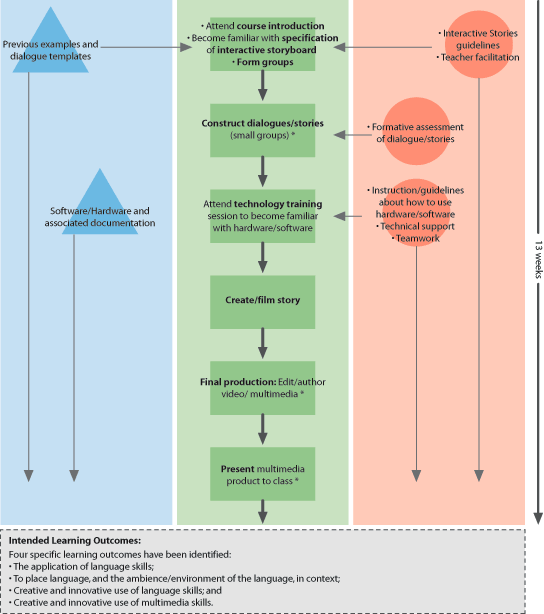|
WHAT THE STUDENTS DO
In Interactive Stories, students work in groups to
create an interactive multimedia module, usually in the form
of a "choose your own adventure" story or "conversation"
with a user. The end result is a multimedia version of a "choose
your own adventure" story. One side of the "conversation"
is provided by digital video segments played on the computer.
After each segment, the user is presented with a set of branching
points, usually presented as text. As a choice is made, a
subsequent video segment is played, resulting in a complex
interweaving of narratives and responses. Students are asked
to create one of these for their peers to use.
Introduction: The first activity involves
introducing students to the project, the concept, the specific
learning outcomes, and the schedule of activities. This session
usually involves demonstrating examples of previous student
projects, including time for students to explore the examples.
It may be important to provide students with specific guidelines
about the scope and style of project that is expected, particularly
for beginner language learners. For example, as beginner language
learners are yet to develop an extensive vocabulary, you may
suggest simple scenarios such as shopping exchanges.
Scripting: The second activity has students
working in small groups (two or three students) scripting
their stories/conversations/dialogues. This activity can be
facilitated by providing students with guidelines for developing
an "Interactive Stories" script and/or asking them
to deconstruct a simple example first.
Following this activity it is useful to provide formative
assessment in the form of feedback regarding the script. This
can save a great deal of time in the filming/editing stage
by ensuring the script "makes sense". It is also
an opportunity to improve the quality of the final production
by making language corrections such as grammar, spelling and
context.
Technology training: The next stage is
referred to as the technology training session and involves
providing students with instruction regarding use of the digital
video camera (including basic filming tips), video capture
and editing using iMovie, and the multimedia authoring using
StoryTime. Depending on time and scope of project, this stage
may be divided into two sessions, the video parts before the
filming stage, and the multimedia authoring after.
Creating the multimedia "story":
The next stage involves each group of students gaining access
to a digital video camera and tape. Tripod, lighting and microphone
may improve experience and final production, however are not
considered essential. Students often use a variety of props
and locations for this stage. It is essential that a booking
process be established to handle the use of equipment in this
stage. It is likely that each group will take a few hours
for filming.
Once filming is complete, each group will then require access
to computer hardware and software. The first step requires
the digital video camera and involves importing the filmed
footage from the camera into iMovie. Once the footage has
been imported, students will then edit the video as desired
and export each short video clip from iMovie as a QuickTime
movie for inclusion into their Interactive Story (the camera
is not required during the editing stage). The last step is
to transfer the script into StoryTime, construct the appropriate
links and insert the video clips.
Presenting: The final stage involves each
student group presenting the final productions to the whole
class. This session is usually a lot of fun as students share
the experiences of their journey.
SIGNIFICANCE OF ORDER
The sequence of activities for the Interactive Stories learning
design has been refined over a number of projects. The sequence
of the technical session is the most variable, however it
is the experience of the authors that this activity is best
sequenced shortly before student use the skills learned. Dividing
the technical sessions into two parts can be useful to facilitate
this, however many students reported that it is useful to
understand the technical issues at the outset as it helps
them to frame their project.
The presentation activity may need to be carried over more
than one teaching session depending on the number of groups.
CRITICAL ACTIVITIES
The learning design described here has been developed with
a number of variations. One variation has students creating
short films rather than Interactive Stories. The advantage
of this is that it reduces the level of technical training
and allows students to develop and focus their creativity
on the filming aspects. The limitation of this approach is
that it may not encourage students to explore the written
aspect of the target language.
|
